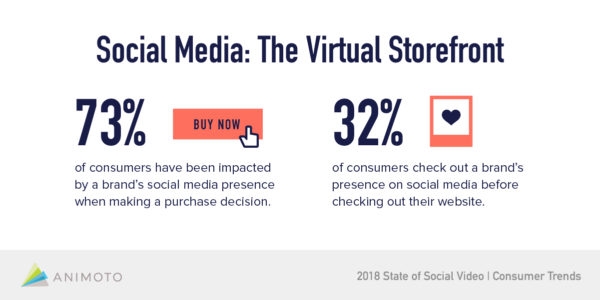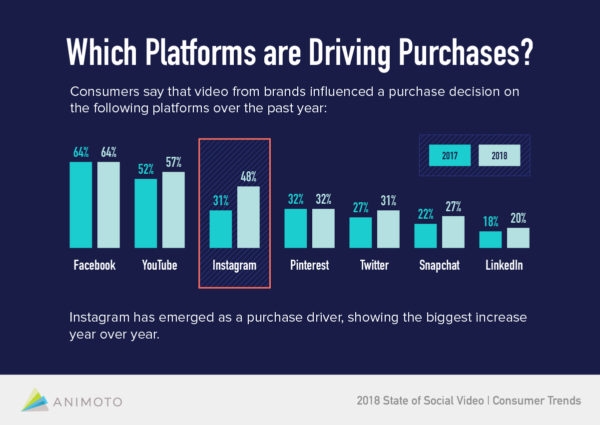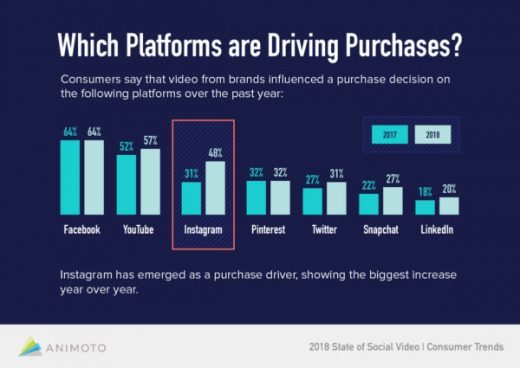Instagram Stats and Trends to Guide Your 2019 Strategy
— January 17, 2019
With 1 billion monthly active accounts on Instagram, half of which are active on a daily basis, it’s no wonder Instagram continues to be a priority for marketers and small business owners. What started as a photo-sharing platform is quickly transforming into an ecommerce hub that lets brands be discovered, convert new customers, and engage with fans.
With Instagram’s constant evolution of features, it might seem like a daunting endeavor for marketers. Facebook itself realizes that brands are playing catch up on Instagram. “Consumers often adopt new technologies before businesses do. Our competitive advantage is helping advertisers close that gap,” Sheryl Sandberg said in Facebook’s most recent earnings call.
In other words, Instagram is where consumers are embracing new features and expecting marketers to do the same. If you want to be sure you’re ready for the mobile-centric world of Instagram marketing, check out this 2019 guide and get the latest strategy and stats.
Instagram Is a Land of Discoverability for Brands
In Facebook’s January 2018 earnings call, Sheryl Sandberg stated that two-thirds of people who visit Instagram business profiles don’t yet follow that brand. It’s undeniable that Instagram is a place for brands to get discovered.
During Facebook’s more recent Q3 2018 earnings call, it was revealed that “about 20%” of the time people spend on Instagram is in the Explore tab. While Facebook is very keen on developing a sense of community on Facebook, they seem to be making Instagram a space for discoverability.
In a global survey, 1 in 3 self-reported daily active Instagrammers in the US, Brazil, Indonesia, and the UK indicated that they had become more interested in a brand or product after seeing it on Instagram Stories. While Instagram might be a place for early funnel discovery, it’s also a place where consumers are thinking about purchase decisions.
According to Animoto’s State of Social survey, 73% of consumers state that they are impacted by a brand’s social media presence when making a purchase decision, and 32% state that they look at a brand’s social media accounts before their website.

It’s clear that social media in general (and Instagram especially) is a key place for consumers to decide if a product or brand interests them. By the time many consumers have reached a website, they are usually fairly far along the buyer’s journey thanks to platforms like Instagram.
Feed vs Stories
Marketers can and should still think about their Instagram Feed and treat it differently than they do Stories. Facebook certainly still considers it strategically important and therefore will continue to prioritize features that capture consumers’ attention and marketers’ ability to target their audience. During Facebook’s Q3 earnings call, Sheryl Sandberg said that “feed ads on Facebook and Instagram represent the majority of our revenue growth and the majority of opportunities for marketers to generate ROI.”
The key for marketers on Instagram, whether advertising or posting organically, is to understand the differences between the two platforms. The Feed has evolved into a curated extension of a brand’s online presence, while Stories is where consumers get to connect more authentically with brands.
Other than the type of content posted to each platform, marketers should also consider the aspect ratio format differences between Stories and Feed. Stories have to be in a vertical, 9:16, ratio. However, that vertical aspect ratio doesn’t work in Instagram Feed. The options there are 1:1 (square), a less full-screen vertical option (4:5) and landscape (1:91:1). Facebook recommends square or vertical for all their platforms, given the mobile-friendly aesthetic of those formats. These formats also help brands stand out on social. Square photos or videos, for instance, take up 78% more real estate on screens than landscape photos or videos.
Below is an example from The Jane Goodall Institute. They have been successfully using square videos on Facebook for the last couple of years for fundraising after finding that square videos received more shares and likes. They have also started using square videos to Instagram with great success. For instance, the video below received over 800,000 views.
Another consideration: while Facebook recommends that markets “design for sound off but delight with sound on” when it comes to video, that rule of thumb might not hold true for Instagram Stories. According to Facebook, 60% of Instagram Stories videos are watched with the sound on. Designing for sound off typically means relying on text to add context. Whether captioning talking-head videos or creating editorial video content that has enticing, legible text to move the story along (like the Dodo or Buzzfeed) , mobile content typically needs to work in a sound-off environment. Instagram Stories is a more immersive experience that welcomes sound into the fold.
Knowing the difference between these platforms in terms of storytelling norms and best practices is key to looking professional on Instagram.
Video on Instagram Is on the Rise
What started off as a photo-sharing app is now transforming into an ecommerce juggernaut. And where there is advertising, there is always video.
Every year Animoto asks consumers if they have made a purchase due to a brand’s video on major social media platforms. Instagram saw a notable spike. 48% of consumers on Instagram said that they have made a purchase due to a brand’s video on the platform in 2018. This was a significant increase from 32% last year. It was by far the biggest spike in year-over-year growth of any social media platform.

In the same survey, 47% of consumers on Instagram said they enjoyed watching ads within Instagram Stories. With nearly half of consumers actually like advertising within Stories, it’s clear that advertising efforts are resonating with the nearly 400 million active Instagram Stories users.
It’s still questionable whether IGTV will see the same success as Stories. Facebook is reticent to provide statistics about its usage. It does seem that Facebook is committed to maintaining ecosystems on their platforms that are dedicated to video. Video undoubtedly helps them unlock advertising spend while keeping users in their apps longer. However, Mark Zuckerberg has also been on the record as saying that video “displaces some social interactions, and people tell us it makes the experience less valuable, even though they’re spending more time on it. So the solution to this has been building separate video experiences outside of our feeds, with Watch on Facebook and IGTV on Instagram.”
IGTV, IG Stories, and organic or ad content in the Instagram ecosystem will continue to drive more and more video on Instagram. Each has its own nuance and needs a different approach from marketers.
Conclusion
Instagram is going to continue to evolve as it works to maintain consumers’ attention. It’s up to marketers to keep up. Facebook is guaranteeing that this platform will be relevant to brands by continuing to evolve it as a place where consumers can discover them.
Instagram is one of the key places for brands to get a new audience and move them along the purchase-decision process. Marketers must stay agile and adapt their strategy as the platform continues to change.
Digital & Social Articles on Business 2 Community
(123)


